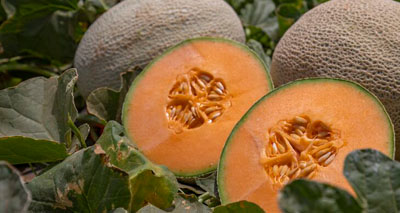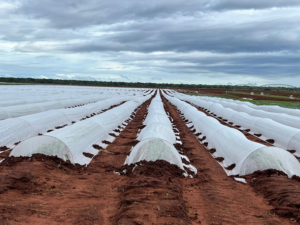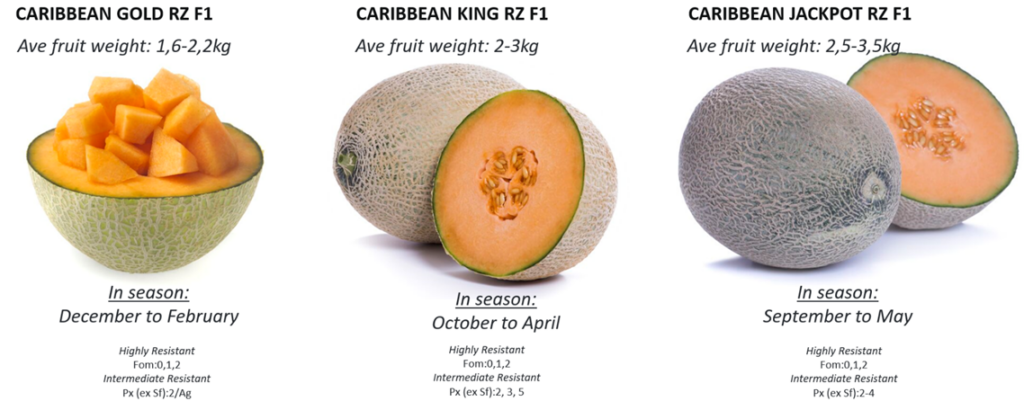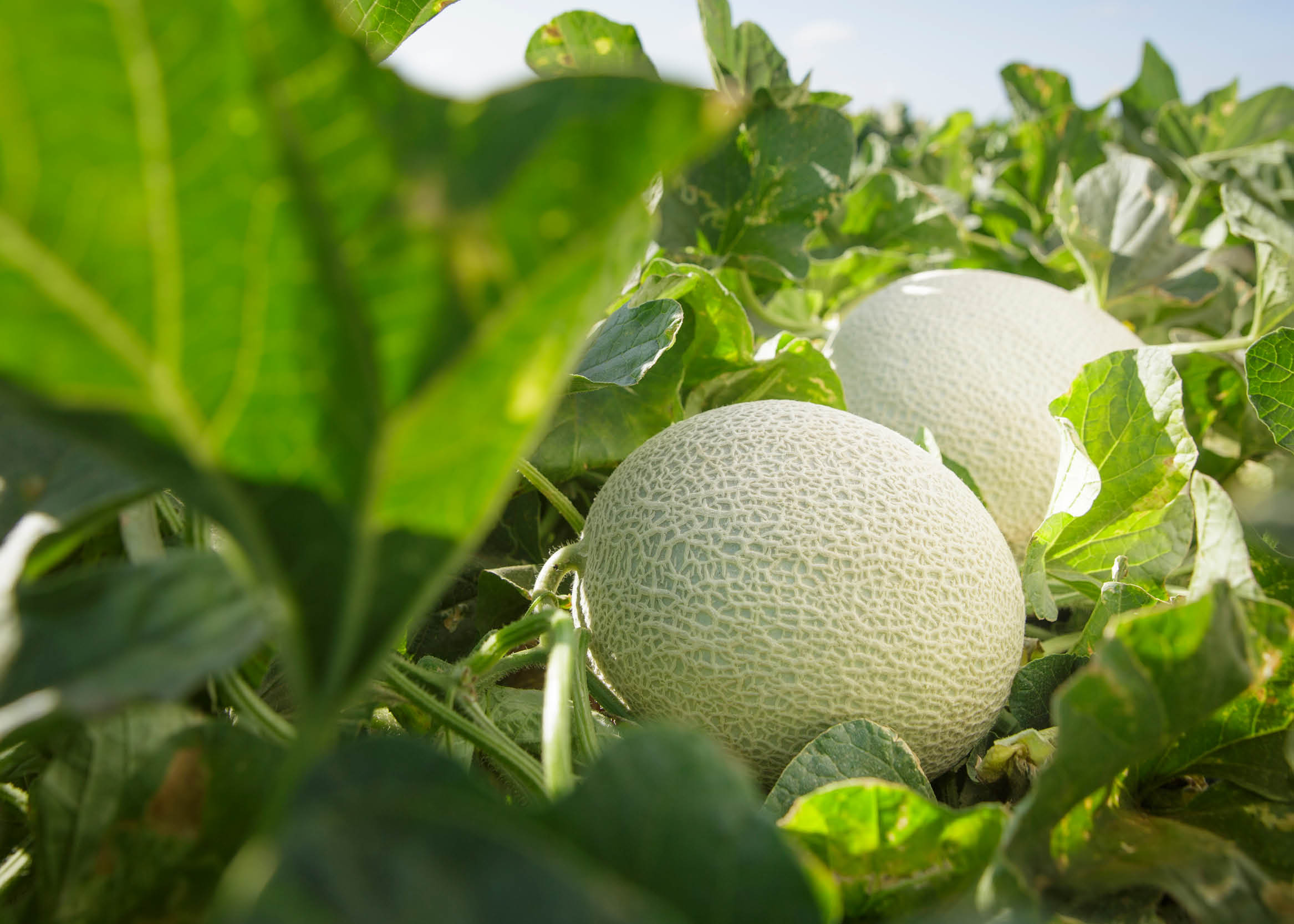
Content
- Field Preparations
- Plant Density
- Variety Choice
- Planting
- Growing Phases
- Irrigation & Fertilization
- Pest Management
- Pollination
- Quality Control
- Packaging
1. Melon Field Preparations:
Many different cultivating methods are used all over the world to grow melons.
In Southern Africa melons are predominately planted open field on ridges with drip irrigation and plastic mulching.
- Rip and loosen bottom soil.
- Mark planting rows.
- Apply plant fertilizer in plant rows.
- Ridge topsoil 200mm-250mm.
- Put plastic mulching on ridges.
- Burn holes at the drippers for plants, 50 mm holes for winter and 110 mm holes for summer.
- Plant seedlings. (See plant density chart on next page)
- Apply frost cover over ridges to prevent virus infection from whitefly.



The Plastic Mulching is critical as it helps to keep soil temperatures optimal, control weeds, prevents rainwater to leach nutrients in the ridge and keeps your fruit out of the water and soil.
2. Plant Density:
To ensure optimal fruit set and fruit size, it is critical to plant according the recommend plant density.
10000 plants per Ha, ungrafted.
5000 plants per Ha, grafted (Half density).
Make sure to account for a 10% oversow for ungrafted seedlings, and a 30% oversow for grafted seedlings.

(2-meter row spacing and 0,50 drip spacing is most commonly used)
3. Variety Choice:
The melon market varies from country to country and requires different fruit characteristics. The biggest market in Southern Africa is the Wester Shipper, long shelf-life musk melons.
The market is very size sensitive and prefers a specific size for packaging purposes. (See Packaging Page)
The Rijk Zwaan Caribbean Melon assortment offers different varieties according to planting season and specific climate. Please consult with your Rijk Zwaan representative for varietal recommendations.


4. Planting:
Melons can be planted directly seeded in the soil, however if planted in the rainy season seedlings should be used. The rain washes the seeds out of the soil and compacts the soil, making it very difficult for the seeds to germinate.
Planting seeds directly:
- Ensure the ridge is properly irrigated with at least 80% moisture.
- Plant the seeds by hand by pushing the seed into the soil 10mm-15mm deep.
- Close the hole with topsoil.
- Drench plant hole with a cup of water to ensure optimal soil contact on the seed.

Planting Seedlings:
- When planting seedlings the back of a broom stick could be used to punch holes in the soil for the seedlings plugs.
- Plant the seedlings in the hole.
- Carefully cover the top of the plug with topsoil.
- Don’t push the seedling from the top, it will damage the plug and the root system will “J root”.
- Drench the plant hole with a cup of water to ensure optimal soil contact with the seedling plug.

5. Growing Phases:


Growing Phase:
- In this phase the plants need a full set of fertilizers and enough water.
- Be sure to keep up with the work: the plants can grow by 10cm p/day!
- Keep plant in balance with EC control.
- Ensure strong root flush.
Setting Phase:
- Monitor the plant regularly for the first open flower on female fruits.
- Use bees to pollinate open female flower.
- Spread the beehives, 1 hive per Ha.
- A Boron application can be done to improve flower quality.
- Don’t use a pesticide during this phase that could be harmful to the bees.
- Moisture control is critical during this phase.
Filling Phase:
- During this phase the plants use a lot of water to fill the fruit, Monitor soil moisture regularly and keep moisture above 80%.
- Give some extra Potassium.
- Prune growth points to preserve energy if needed.
Ripening Phase:
• The last 3 weeks when the net start to form the fruits won’t grow much.
• Some extra K, higher EC and less water help the fruits to become sweet and to have a better shelf life.
• On the last days the sugar continence can rise with 1 brix per day, so don’t pick too early.

6. Irrigation and Fertilization


7. Pest Management:
Powdery Mildew and Downy Mildew:
- Topaz
- Bravo 729
- Oscar
- Benomyl
- Bumper
- Collis
- Amistar 250 SC
- Ridomyl gold
Red-Spider Mite:
- Agrimec Gold
- Crystal
Whitefly, Aphids and Thrips:
- Actara
- Harrier
- Mospilan
- Karate Zeon
- Kohinor
- Closer
- Chess
- Movento
Bollworm and Looper:
- Dursban
- Harrier
- Methomyl
- Karate
- Belt
- Delfin
- Steward
Fruit Fly:
- Hymlure
- Mercaptation
- GF 120
- Grab
Liriomyza Fly:
- Rimon
8. Pollination
Melons have male flowers and female flowers which form fruit if pollinated properly.
The pollen from the male flowers need help from bees and other insect to be transported to the female flowers, Bees works best for this task!
For optimal fruit set at least 1 beehive per Ha should be spread out over the field.
Keep in mind the beehives can’t stand on the ground because of lurking creatures damaging the hives to get to the honey like honey badgers for example. Special stands should be built to put the beehives on.
The bees also don’t work in overcast whether and that could sometimes lead to the loss of that fruit set.

9. Quality Control:
To grow and protect the Melon market it is crucial that producers supply the market with good quality ripe fruit.
Only pick fruit which is fully ripe and has had a chance to build up some Brix.
Constantly monitor random fruit in the packing process by testing their Brix with a Brix meter.
The market prefers fruit with a Brix value higher than ten.


10. Packaging:
Appearance and the way that the fruits are packed plays a big role in the demand of your final product.
The melon market prefers 6 uniform fruits packed in a box, because in this way you utilise all available space in the box and transport is also much more efficient.
There are different box sizes available for different fruit sizes but 6 fruit in a 158 box are seen as a higher value product.


